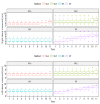Effect of physiotherapeutic procedures on the bioelectric activity of the masseter muscle and the range of motion of the temporomandibular joints in the female population with chronic pain: a randomized controlled trial
- PMID: 38007478
- PMCID: PMC10676580
- DOI: 10.1186/s12903-023-03601-y
Effect of physiotherapeutic procedures on the bioelectric activity of the masseter muscle and the range of motion of the temporomandibular joints in the female population with chronic pain: a randomized controlled trial
Abstract
Introduction: Physical therapy (PT) methods applied in dentistry are increasingly discussed nowadays. Taking into account a rapidly growing number of temporomandibular disorders (TMDs) and orofacial pain patients, it is reasonable to determine which of the available physiotherapeutic (PT) methods are more effective than others, especially in terms of their possible analgesic and myorelaxant effects.
Objective: To assess manual and physical factors influencing pain reduction or elimination and increased muscle tension in patients with TMD; yet the influence of the applied forms of PT on the range of motion (ROM) of temporomandibular joints (TMJ).
Material and methods: A randomized, parallel-group, RCT, single-blind, equi-randomized (1:1) study was conducted in DC/TMD Group Ib patients (20-45 years of age). An experimental group (G1, n = 104) and a control group without TMD (G2, n = 104) were created according to CONSORT guidelines. Diagnostic measurements were performed in both groups (mass sEMG, temporomandibular joint range of motion-ROM, pain intensity - NRS). Group G1 was randomly divided (envelope method) into 4 therapeutic groups, in which therapy was carried out for 10 days: magnetostimulation (MS), magnetoledotherapy (MLE), magnetolaserotherapy (MLA), manual therapy (MT). Each time after the therapy, ROM and NRS measurements were performed, and after the 5th and 10th day sEMG.
Results: Statistically significant differences were found in the sEMG values of the masseter muscles, TMJ ROM and the pain intensity in G1 and G2 (p < 0.00). The largest decrease in sEMG (% MVC) of the masseter muscle occurred in the subgroup in which the manual therapy (MT) procedures were applied, p < 0.000. There was no clinically significant difference in and between other subgroups. There was a distinct mandible ROM increase noted in the MT group, with minimal changes in the MLA and MLE groups and no changes in the MS group. There was a clear increase in the lateral mobility of both right and left TMJ in the MT group. There were no differences in the course of the study in the MS group, and slight increases in the MLA and MLE groups. In the case of pain measurements, the greatest decrease in pain intensity was observed in the MT subgroup.
Conclusions: According to our results manual therapy is an effective form of treatment in patients with pain, increased masticatory muscle tension and limitation in mandible ROM. Dental physiotherapy should become an integral part of multimodal TMD patients' treatment.
Keywords: Electromyography; Mandible range of motion; Manual therapy; Orofacial pain; Physiotherapy; TMD; Temporomandibular joint; sEMG.
© 2023. The Author(s).
Conflict of interest statement
The authors declare no competing interests.
Figures





Similar articles
-
Surface electromyography evaluation of selected manual and physical therapy interventions in women with temporomandibular joint pain and limited mobility. Randomized controlled trial (RCT).Injury. 2023 Aug;54(8):110906. doi: 10.1016/j.injury.2023.110906. Epub 2023 Jun 19. Injury. 2023. PMID: 37400325 Clinical Trial.
-
Evaluation of the efficacy of manual soft tissue therapy and therapeutic exercises in patients with pain and limited mobility TMJ: a randomized control trial (RCT).Head Face Med. 2023 Sep 8;19(1):42. doi: 10.1186/s13005-023-00385-y. Head Face Med. 2023. PMID: 37684652 Free PMC article. Clinical Trial.
-
Kinesio Taping as an alternative therapy for limited mandibular mobility with pain in female patients with temporomandibular disorders: A randomized controlled trial.Dent Med Probl. 2024 Sep-Oct;61(5):659-670. doi: 10.17219/dmp/173126. Dent Med Probl. 2024. PMID: 38832764 Clinical Trial.
-
The significance of masticatory muscle's relaxation in the treatment of the temporomandibular disorders - Review article.Folia Med Cracov. 2023 Apr 30;63(1):45-52. doi: 10.24425/fmc.2023.145429. Folia Med Cracov. 2023. PMID: 37406276 Review.
-
Surface electromyography in the assessment of masticatory muscle activity in patients with pain-related temporomandibular disorders: a systematic review.Front Neurol. 2023 May 3;14:1184036. doi: 10.3389/fneur.2023.1184036. eCollection 2023. Front Neurol. 2023. PMID: 37206909 Free PMC article. Review.
Cited by
-
Surface Electromyography in Dentistry-Past, Present and Future.J Clin Med. 2024 Feb 26;13(5):1328. doi: 10.3390/jcm13051328. J Clin Med. 2024. PMID: 38592144 Free PMC article. Review.
-
Assessment of pain location according to different types of bruxism.J Oral Facial Pain Headache. 2025 Mar;39(1):157-164. doi: 10.22514/jofph.2025.016. Epub 2025 Mar 12. J Oral Facial Pain Headache. 2025. PMID: 40129434 Free PMC article.
-
Analysis of the Use of Sample Size and Effect Size Calculations in a Temporomandibular Disorders Randomised Controlled Trial-Short Narrative Review.J Pers Med. 2024 Jun 19;14(6):655. doi: 10.3390/jpm14060655. J Pers Med. 2024. PMID: 38929876 Free PMC article. Review.
References
Publication types
MeSH terms
LinkOut - more resources
Full Text Sources
Medical

